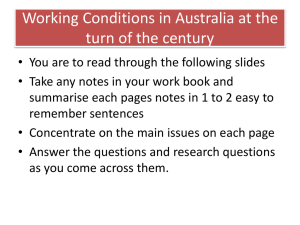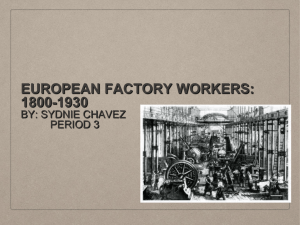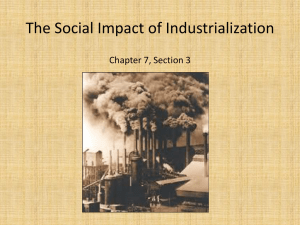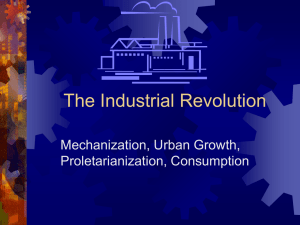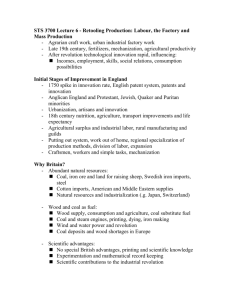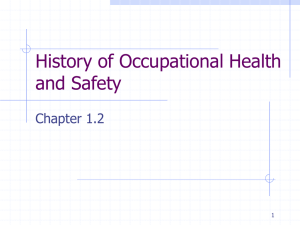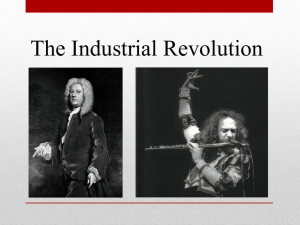18th Century Working Conditions Powerpoint
advertisement
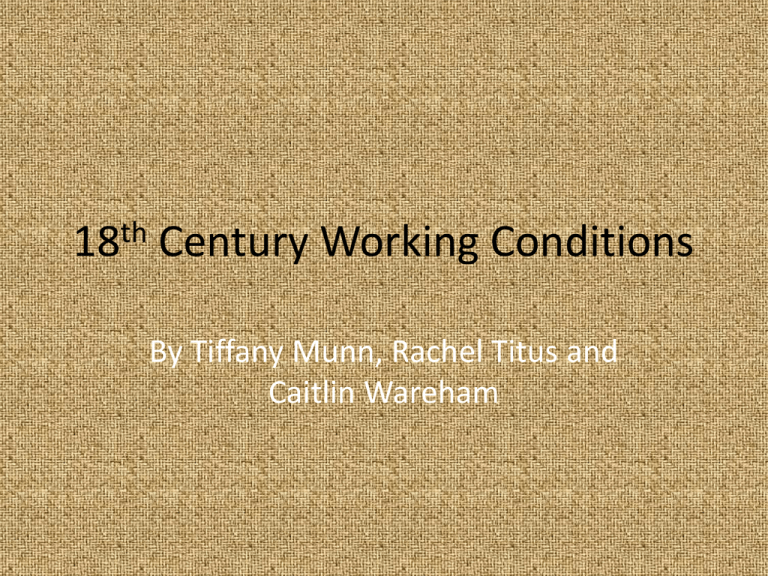
th 18 Century Working Conditions By Tiffany Munn, Rachel Titus and Caitlin Wareham A Brief Overview • Working conditions in Britain underwent drastic changes in the 18th century • The advent of the Industrial Revolution changed the atmosphere and pace of the workplace; these changes were not always met with enthusiasm • While poor working conditions were nothing new, industrialization brought a new set of challenges and hazards to the already daunting task of making a living • In general, what was good for business and factory owners was not all that great for people (some things just don’t change!) The Industrial Revolution • The Industrial Revolution occurred in the 18th and 19th Centuries • Radical changes were made to many areas, such as technology, manufacturing, transportation • These changes forever altered the course of the world and shaped modern society The Industrial Revolution • Changes to Technology: Mechanization of industry; machines were developed that increased efficiency in the textile, mining and metal industries • Changes to Manufacturing: While manufacturing formerly relied on individual craftsmen and artisans, the advent of factories and machinery enabled record production; machines increased the output from individual workers • Changes to Transportation: Steam-powered ships were invented; the prevalence of railways allowed for a greater number of people to be transported at once and made travel faster and easier What did this mean for workers? • One of the most direct consequences of the Industrial Revolution was urbanization • This meant that many people made the move from the country to the city; industrialization created many factory jobs, and workers from rural areas moved to urban centres in search of employment • However, factory work was far different from what many were used to; the working environment was strict, and dictated by the pace of the machines • Some people did not like this; Luddism was a reaction to the mechanization of the workplace • However, this resistance was not strong enough to overcome the inevitability of technological advancement • Overall, industrialization meant that workers had to adjust to a new way of life and a new work environment From Farms... To Factories Types of work • The most common type of work was factory work; many textile factories producing such things as cotton, yarn, linen, etc. Made other things such as glass, soap, etc. • Mining, particularly for coal • Metal industry, particularly wrought iron SAFE!!! Treatment of Adult Workers • Men and women worked long hours with little pay • The factories were filled with germs and usually infested with rats, causing many health problems such as cholera • Later there would be laws put in effect to protect workers in the factories. The factory Act of 1819limited hours worked by children to 10hrs per day. Work Hazards • Injuries were a daily occurrence, most of the machinery was unprotected • The injuries could have been as mild as burns to the hands or arms, or as severe as having limbs amputated by the machinery, or death • Thousands of people were wounded by machinery • Factory owners did not compensate family’s for their loss, the injured worker would be replaced • In 1837, the “Fellow Servant” rule was applied, employers not held responsible for a worker’s negligence of a fellow employee. Working Conditions in Prison • Prisons during the 18th century were filthy and overcrowded with no privacy. • Prisoners had to provide their own food and had little access to fresh drinking water. • Some workers picked Oakum, pulling apart tarred rope into fibres; this made their hands bleed and was very painful. • They had to pay the gaoler for every service, even for their punishments. • Those who had no money were forced to beg from local people passing the prison. Child Labour • Children as young as four worked as much as 16 hours a day • Children earned approx. 1020% of what an adult male made working in the same position; 2-4 shillings/day for a child under the age of 11, 4-10 shillings /day for a child over the age of 11 • Either worked to help family or children were placed in debtors prison to pay a family’s debt. Child Labour Cont’d • Child labourers worked in cotton mills, metal fabrication plants, in mines, as blacksmiths, and most commonly as chimney sweeps. • Dangerous and fatal conditions: exposure to coal dust and phosphorus fumes, machinery limb loss, gas explosions • Abandoned or orphaned children were sold by parliament or the church and became the property of factories: working for food and lodging, called “pauper apprentices.” • On a more positive note, things didn’t stay this terrible forever Reform • Factory Act of 1833 limited the amount of time children could work, even gave them an hour lunch break (small steps) • Also outlawed the employment of children under 9 in the textile industry, and stated that children could not work at night Reform Cont’d • Other laws forced textile factory owners to clean up their act, in an effort to put an end to filthy work environments (Factory Act of 1844) • Factory owners were also forced to keep records and investigate all deaths that occurred • Factories were inspected to make sure all laws were being complied with • Other laws made education compulsory for all children up until the age of 10 Reformers and Advocates VS. Lord Althorp 1782-1845 Richard Carlile 1790-1843 Advocates: Lord Althorpe • Lord Althorpe was Chancellor of Exchequer and leader of the house of commons • Supported the idea of a 10 hour workday for children (NICE) • Also opposed child labour laws, such as the Factories act of 1833 • This law reduced the number of hours that children, particularly young children, could work, and mandated that these children must be given at least 2 hours of education a day • Apparently Lord Althorpe wasn’t a “kid” person Reformers: Richard Carlile • Was a former child labourer, probably had a better perspective than Lord Althorpe regarding the plight of child workers… • Father abandoned the family, and Carlile was forced to work in a tin factory • Became a reformer in parliament, advocating for the working class • Was imprisoned for some of his writings, which opposed, among other things, wage cuts for miners William Blake 1757-1827 •Anti-child labour writer of the Romantic Period •Songs of Innocence and Experience: explored his views on child labour, religious views, poverty, and family views •Made art and engravings to accompany his poems •Chimney Sweeper- about child labour and religious matters Songs of Innocence and Songs of Experience • Shows the contrast between the Catholic church view of child labour by orphans and William Blake’s view of child labour Songs of Innocence: “So, if all do their duty, they need not fear harm. “ “So your chimneys I sweep, and in soot I sleep” “And the angel told Tom, if he'd be a good boy, He'd have God for his father, and never want joy” Songs of Experience: “They clothed me in the clothes of death” “They think they have done me no injury” “Who made up a heaven of our misery” In Conclusion... • The Industrial Revolution brought a lot of changes and shaped the modern world. Some of these changes were positive, in terms of business and economics. • However, some changes were negative, particularly for the people working in factories. The working poor definitely got a raw deal. • Adult workers were forced to make do with extremely substandard environments and poor treatment; the dangers of factory work were many. • Children were even worse off than adults. • Thankfully, reform was slowly introduced to protect factory workers and put an end to child labour in England. Questions 1. Do you think that the many innovations of the Industrial Revolution justified the amount of suffering to workers? Could it have been prevented? 2.How was the Factory Act of 1819 crucial for women, men and children? 3. Was William Blake too critical of the church’s treatment of oprhaned children? Photo Souces • http://www.uky.edu/~popkin/frenchworker/w orkcondition.htm • http://www.doverkent.co.uk/places/priory.htm • http://www.nettlesworth.durham.sch.uk/time /victorian/vindust.html • http://www.bbc.co.uk/learningzone/clips/chil dren-working-in-coal-mines/145.html • https://www.dovergramboys.kent.sch.uk/
